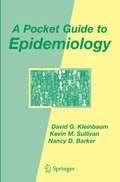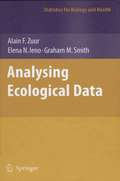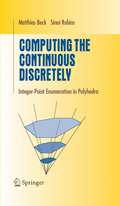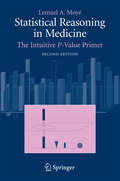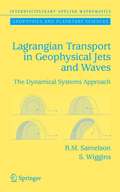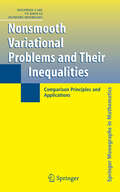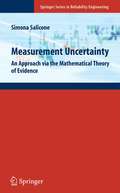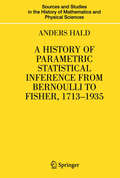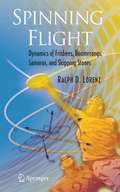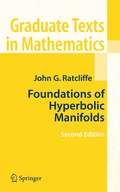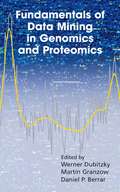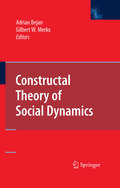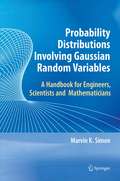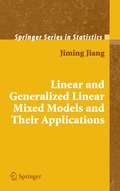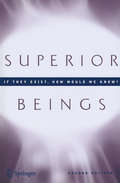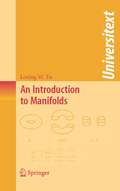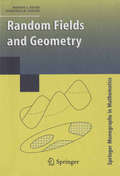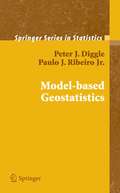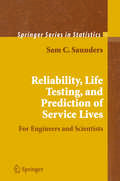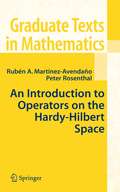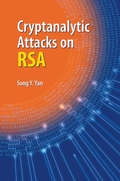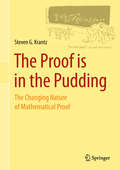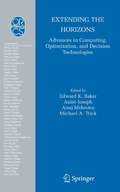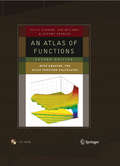- Table View
- List View
A Pocket Guide to Epidemiology
by David G. Kleinbaum Kevin M. Sullivan Nancy D. BarkerIn the nearly three years since the publication of the ActivEpi companion text, the authors received several suggestions to produce an abbreviated version that narrows the discussion to the most "essential" principals and methods. A Pocket Guide to Epidemiology contains less than half as many pages as the ActivEpi Companion Text and is a stand-alone introductory text on the basic principals and concepts of epidemiology.
Analyzing Ecological Data (Statistics for Biology and Health)
by Alain Zuur Elena N. Ieno Graham M. SmithThis book provides a practical introduction to analyzing ecological data using real data sets. The first part gives a largely non-mathematical introduction to data exploration, univariate methods (including GAM and mixed modeling techniques), multivariate analysis, time series analysis, and spatial statistics. The second part provides 17 case studies. The case studies include topics ranging from terrestrial ecology to marine biology and can be used as a template for a reader’s own data analysis. Data from all case studies are available from www.highstat.com. Guidance on software is provided in the book.
Computing the Continuous Discretely: Integer-point Enumeration in Polyhedra (Undergraduate Texts in Mathematics)
by Matthias Beck Sinai RobinsThis textbook illuminates the field of discrete mathematics with examples, theory, and applications of the discrete volume of a polytope. The authors have weaved a unifying thread through basic yet deep ideas in discrete geometry, combinatorics, and number theory. We encounter here a friendly invitation to the field of "counting integer points in polytopes", and its various connections to elementary finite Fourier analysis, generating functions, the Frobenius coin-exchange problem, solid angles, magic squares, Dedekind sums, computational geometry, and more. With 250 exercises and open problems, the reader feels like an active participant.
Statistical Reasoning in Medicine: The Intuitive P-Value Primer
by Lemuel A. MoyéThe 2nd Edition of this popular book emphasizes patient and community protection, illustrates the correct use of statistics in health care research for healthcare workers and adds considerable new and updated information. The new edition smooths the learning curve for health care researchers, further de-emphasizing mathematical and computational devices and bringing the principles of statistical reasoning into reach for the uninitiated. New figures, discussion and illustrations fortify each chapter. In addition, three new appendices have been added on the normal distribution, sample size computations, and new requirements for the use of statistics in the courtroom.
Lagrangian Transport in Geophysical Jets and Waves: The Dynamical Systems Approach (Interdisciplinary Applied Mathematics #31)
by Roger M. Samelson Stephen WigginsWritten jointly by a specialist in geophysical fluid dynamics and an applied mathematician, this is the first accessible introduction to a new set of methods for analysing Lagrangian motion in geophysical flows. The book opens by establishing context and fundamental mathematical concepts and definitions, exploring simple cases of steady flow, and touching on important topics from the classical theory of Hamiltonian systems. Subsequent chapters examine the elements and methods of Lagrangian transport analysis in time-dependent flows. The concluding chapter offers a brief survey of rapidly evolving research in geophysical fluid dynamics that makes use of this new approach.
Nonsmooth Variational Problems and Their Inequalities: Comparison Principles and Applications (Springer Monographs in Mathematics)
by Siegfried Carl Vy K. Le Dumitru MotreanuThis monograph focuses primarily on nonsmooth variational problems that arise from boundary value problems with nonsmooth data and/or nonsmooth constraints, such as multivalued elliptic problems, variational inequalities, hemivariational inequalities, and their corresponding evolution problems. It provides a systematic and unified exposition of comparison principles based on a suitably extended sub-supersolution method.
Measurement Uncertainty: An Approach via the Mathematical Theory of Evidence (Springer Series in Reliability Engineering)
by Simona SaliconeThe expression of uncertainty in measurement poses a challenge since it involves physical, mathematical, and philosophical issues. This problem is intensified by the limitations of the probabilistic approach used by the current standard (the GUM Instrumentation Standard). This text presents an alternative approach. It makes full use of the mathematical theory of evidence to express the uncertainty in measurements. Coverage provides an overview of the current standard, then pinpoints and constructively resolves its limitations. Numerous examples throughout help explain the book’s unique approach.
A History of Parametric Statistical Inference from Bernoulli to Fisher, 1713-1935 (Sources and Studies in the History of Mathematics and Physical Sciences)
by Anders HaldThis book offers a detailed history of parametric statistical inference. Covering the period between James Bernoulli and R.A. Fisher, it examines: binomial statistical inference; statistical inference by inverse probability; the central limit theorem and linear minimum variance estimation by Laplace and Gauss; error theory, skew distributions, correlation, sampling distributions; and the Fisherian Revolution. Lively biographical sketches of many of the main characters are featured throughout, including Laplace, Gauss, Edgeworth, Fisher, and Karl Pearson. Also examined are the roles played by DeMoivre, James Bernoulli, and Lagrange.
The Health of Aging Hispanics: The Mexican-Origin Population
by Jacqueline L. Angel Keith E. WhitfieldThis timely and much-needed book addresses the demographic trends affecting the Latinos in the United States, Mexico and Latin America, looking at the health concerns and of this growing population, as it ages. Further examination of this previously understudied group– now the nation’s largest minority group – offers the possibility to promote healthy aging for the entire nation. As international immigration continues to increase, collections such as this are critical for understanding the social and health consequences of this immigration.
Spinning Flight: Dynamics of Frisbees, Boomerangs, Samaras, and Skipping Stones
by Ralph D. LorenzMore frisbees are sold each year than baseballs, basketballs and footballs combined. Yet these familiar flying objects have subtle and clever aerodynamic and gyrodynamic properties which are only recently being documented by wind tunnel and other studies. In common with other rotating bodies discussed in this readily accessible book, they are typically not treated in textbooks of aeronautics and the literature is scattered in a variety of places. This book develops the theme of disc-wings and spinning aerospace vehicles in parallel. Since many of the examples are recreational, anyone who enjoys these activities will likely find it profitable and enjoyable. In addition to spinning objects of various shapes, several exotic manned aircraft with disc planforms have been proposed and a prototypes built – these include a Nazi ‘secret weapon’ and the De Havilland Avrocar, also discussed in the book. Boomerangs represent another category of spinning aerodynamic body whose behavior can only be understood by coupling aerodynamics with gyrodynamics. The narrative, supported by equations and graphs, explains how the shape and throw of a boomerang relates to its trajectory. The natural world presents still other examples, namely the samaras or ‘seed-wings’ of many tree species, which autorotate during their descent, like a helicopter whose engine has failed. The flight performance of these spinning wings directly affects the dispersal and thus the evolutionary competitiveness of the trees concerned. Samara-type configurations are also considered for instrumentation and other payload dispersal applications. In short, the book discusses a range of familiar, connected, but largely undeveloped, topics in an accessible, but complete, manner. From the reviews of the first edition: "In his fascinating book Spinning Flight, Ralph Lorenz provides a rich feast of … examples of spinning bodies … . The book is well organized … . The discussion in the book … should be accessible to readers with some elementary understanding of aerodynamic principles. For the expert, the book is full of open problems … . Its scope is extensive … . In this respect, there may be something for everyone within its attractively designed cover … ." (H. K. Moffatt, Nature, Vol. 444, December, 2006) "If you liked physics at school, then this book is for you. It concerns itself with flying objects that spin through the air, and even tells you how to impress your friends with the biomechanics of Frisbees. … there is plenty of information at all levels, and the book has a wealth of detail that only an aerospace engineer like Lorenz could have come up with." (Len Fisher, BBC Focus, February, 2007)
Foundations of Hyperbolic Manifolds (Graduate Texts in Mathematics #149)
by John RatcliffeThis heavily class-tested book is an exposition of the theoretical foundations of hyperbolic manifolds. It is a both a textbook and a reference. A basic knowledge of algebra and topology at the first year graduate level of an American university is assumed. The first part is concerned with hyperbolic geometry and discrete groups. The second part is devoted to the theory of hyperbolic manifolds. The third part integrates the first two parts in a development of the theory of hyperbolic orbifolds. Each chapter contains exercises and a section of historical remarks. A solutions manual is available separately.
Fundamentals of Data Mining in Genomics and Proteomics
by Werner Dubitzky Martin Granzow Daniel P. BerrarThis book presents state-of-the-art analytical methods from statistics and data mining for the analysis of high-throughput data from genomics and proteomics. It adopts an approach focusing on concepts and applications and presents key analytical techniques for the analysis of genomics and proteomics data by detailing their underlying principles, merits and limitations.
Constructal Theory of Social Dynamics
by Adrian Bejan Gilbert W. MerkxConstructal Theory of Social Dynamics brings together for the first time social scientists and engineers who present predictive theory of social organization, as a conglomerate of mating flows that morph in time to flow more easily. The book offers a new way to look at social phenomena as part of natural phenomena, and examines a new domain of application of engineering such as thermodynamic optimization, thermoeconomics and "design as science".
Probability Distributions Involving Gaussian Random Variables: A Handbook for Engineers and Scientists
by Marvin K. SimonThis handbook, now available in paperback, brings together a comprehensive collection of mathematical material in one location. It also offers a variety of new results interpreted in a form that is particularly useful to engineers, scientists, and applied mathematicians. The handbook is not specific to fixed research areas, but rather it has a generic flavor that can be applied by anyone working with probabilistic and stochastic analysis and modeling. Classic results are presented in their final form without derivation or discussion, allowing for much material to be condensed into one volume.
Linear and Generalized Linear Mixed Models and Their Applications (Springer Series in Statistics)
by Jiming JiangThis book covers two major classes of mixed effects models, linear mixed models and generalized linear mixed models. It presents an up-to-date account of theory and methods in analysis of these models as well as their applications in various fields. The book offers a systematic approach to inference about non-Gaussian linear mixed models. Furthermore, it includes recently developed methods, such as mixed model diagnostics, mixed model selection, and jackknife method in the context of mixed models. The book is aimed at students, researchers and other practitioners who are interested in using mixed models for statistical data analysis.
Superior Beings. If They Exist, How Would We Know?: Game-Theoretic Implications of Omnipotence, Omniscience, Immortality, and Incomprehensibility
by Steven BramsThis book examines theology and the idea of a superior being in the context of game theory. The central question posed in this book is: If there existed a superior being who possessed the supernatural qualities of omniscience, omnipotence, immortality, and incomprehensibility, how would he/she act differently from us? The mathematical theory of games is used to define each of these qualities, and different assumptions about the rules of play in several theological games that might be played between ordinary human beings and superior beings like God are posited.
An Introduction to Manifolds (Universitext)
by Loring W. TuIn this streamlined introduction to the subject, the theory of manifolds is presented with the aim of helping the reader achieve a rapid mastery of the essential topics. By the end of the book the reader should be able to compute, at least for simple spaces, one of the most basic topological invariants of a manifold, its de Rham cohomology. Along the way the reader acquires the knowledge and skills necessary for further study of geometry and topology. The requisite point-set topology is included in an appendix of twenty pages, while other appendices review facts from real analysis and linear algebra. Hints and solutions are provided to many of the exercises and problems.
Random Fields and Geometry (Springer Monographs in Mathematics)
by R. J. Adler Jonathan E. TaylorThis monograph is devoted to a completely new approach to geometric problems arising in the study of random fields. The groundbreaking material in Part III, for which the background is carefully prepared in Parts I and II, is of both theoretical and practical importance, and striking in the way in which problems arising in geometry and probability are beautifully intertwined. "Random Fields and Geometry" will be useful for probabilists and statisticians, and for theoretical and applied mathematicians who wish to learn about new relationships between geometry and probability. It will be helpful for graduate students in a classroom setting, or for self-study. Finally, this text will serve as a basic reference for all those interested in the companion volume of the applications of the theory.
Model-based Geostatistics (Springer Series in Statistics)
by Peter Diggle Paulo Justiniano RibeiroThis volume is the first book-length treatment of model-based geostatistics. The text is expository, emphasizing statistical methods and applications rather than the underlying mathematical theory. Analyses of datasets from a range of scientific contexts feature prominently, and simulations are used to illustrate theoretical results. Readers can reproduce most of the computational results in the book by using the authors' software package, geoR, whose usage is illustrated in a computation section at the end of each chapter. The book assumes a working knowledge of classical and Bayesian methods of inference, linear models, and generalized linear models.
Reliability, Life Testing and the Prediction of Service Lives: For Engineers and Scientists (Springer Series in Statistics)
by Sam C. SaundersThis book is intended for students and practitioners who have had a calculus-based statistics course and who have an interest in safety considerations such as reliability, strength, and duration-of-load or service life. Many persons studying statistical science will be employed professionally where the problems encountered are obscure, what should be analyzed is not clear, the appropriate assumptions are equivocal, and data are scant. In this book there is no disclosure with many of the data sets what type of investigation should be made or what assumptions are to be used.
An Introduction to Operators on the Hardy-Hilbert Space (Graduate Texts in Mathematics #237)
by Ruben A. Martinez-Avendano Peter RosenthalThis book offers an elementary and engaging introduction to operator theory on the Hardy-Hilbert space. It provides a firm foundation for the study of all spaces of analytic functions and of the operators on them. Blending techniques from "soft" and "hard" analysis, the book contains clear and beautiful proofs. There are numerous exercises at the end of each chapter, along with a brief guide for further study which includes references to applications to topics in engineering.
Cryptanalytic Attacks on RSA
by Song Y. YanRSA is a public-key cryptographic system, and is the most famous and widely-used cryptographic system in today's digital world. Cryptanalytic Attacks on RSA, a professional book, covers almost all known cryptanalytic attacks and defenses of the RSA cryptographic system and its variants. Since RSA depends heavily on computational complexity theory and number theory, background information on complexity theory and number theory is presented first, followed by an account of the RSA cryptographic system and its variants. This book is also suitable as a secondary text for advanced-level students in computer science and mathematics.
The Proof is in the Pudding: The Changing Nature of Mathematical Proof
by Steven G. KrantzThis text explores the many transformations that the mathematical proof has undergone from its inception to its versatile, present-day use, considering the advent of high-speed computing machines. Though there are many truths to be discovered in this book, by the end it is clear that there is no formalized approach or standard method of discovery to date. Most of the proofs are discussed in detail with figures and equations accompanying them, allowing both the professional mathematician and those less familiar with mathematics to derive the same joy from reading this book.
Extending the Horizons: Advances in Computing, Optimization, and Decision Technologies (Operations Research/Computer Science Interfaces Series #37)
by Edward K. Baker Anito Joseph Anuj Mehrotra Michael A. TrickThis book represents the results of cross-fertilization between OR/MS and CS/AI. It is this interface of OR/CS that makes possible advances that could not have been achieved in isolation. Taken collectively, these articles are indicative of the state-of-the-art in the interface between OR/MS and CS/AI and of the high caliber of research being conducted by members of the INFORMS Computing Society.
An Atlas of Functions: with Equator, the Atlas Function Calculator
by Keith B. Oldham Jerome Spanier Jan MylandThis book comprehensively covers several hundred functions or function families. In chapters that progress by degree of complexity, it starts with simple, integer-valued functions then moves on to polynomials, Bessel, hypergeometric and hundreds more.
